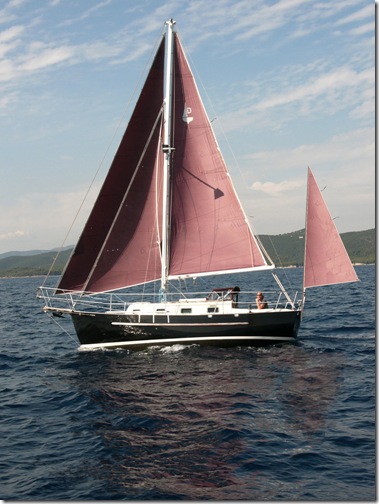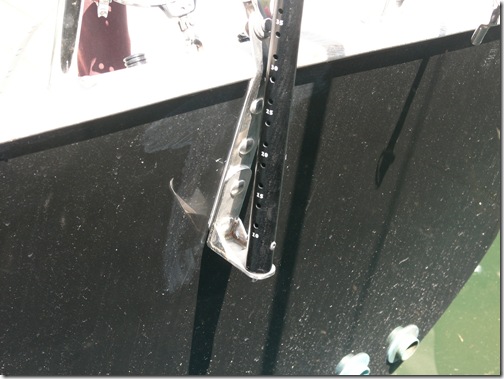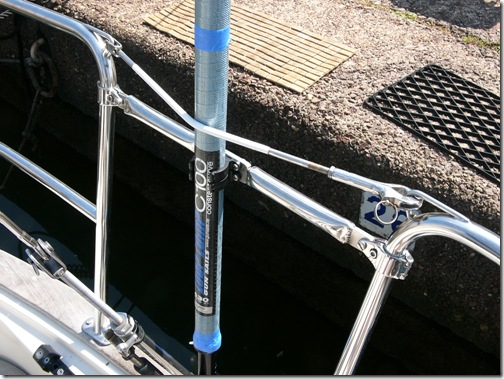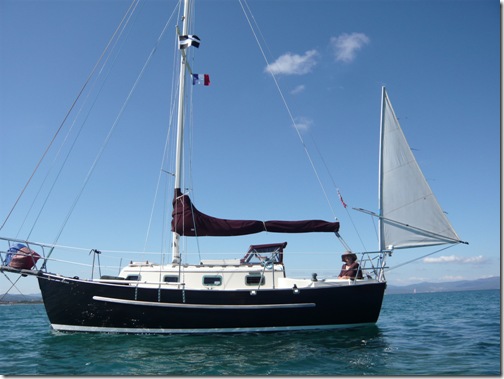This is a Photoshopped picture of Doolittle to see how she would look with a tan coloured mizzen sail.
It was Laurent Giles who said: Your sailing yacht can never be better than a skilful compromise between conflicting considerations. This elegant sentence so sums up yachting and is timeless, no matter how we progress, how much materials and science improves it is always true. Yachts today have highly evolved compromises to suit the modern sailor. Time is short and the modern sailor just wants to step aboard and set off. If conditions aren’t perfect he always has the engine to get him back in time for work on Monday.
Sadly this is pretty much the norm these days, here in the Med seeing yachts with only their mainsails up (or often no sails at all) and all motoring along when they could be sailing. I think the problem is that these modern boats are too compromised. To keep costs down only a simple rig can be acceptable and that means a sloop. It is no surprise that this is the most commonly seen rig. Deficiencies in hull design (from creating double cabins all over the place) can be overcome by the latest autopilots. Sure, these boats will perform well up to a point but if you want to actually sail in the direction (more or less) that you want to go more than just occasionally, you’ll need to improve the standard set up.
A surprisingly effective way to improve a modern sloop is to convert it into a yawl. In the old days this meant seriously modifying your boat to take a second mast and it’s associated rigging but a yawl rig can be easily effected using modern materials. Many yawl critics say that the extra weight and windage of the mizzen mast outweigh the benefits of the sail in the first place, it can even cause the boat to pitch more. This is why it is unusual to see yawl rigged yachts under 40 feet. An efficient mizzen sail for a yawl should be about one quarter the area of the mainsail or about 10% of the working sail area. Since the Dana’s mainsail is 150 sq feet in area, something around 35 sq feet would be appropriate. The working sail area of the Dana is 350 sq feet and this also suggests an area of about 35 sq feet.
Using a carbon mast from a windsurfer as a mizzen mast for a small yacht makes a lot of sense. At just 2 kilos it’s not a lot of weight aft. Since it is so strong and stiff, it needs no stays which reduces weight and rigging. It also means that it does not have to be a permanent feature on the boat. The mast is in two pieces which simple slot together so stowing the set up when not in use shouldn’t be too hard. If you have a small sailing dinghy, well you now have a mast and sail for it!
Having removed the arguments for not having the second mast, lets consider some of the issues that using a carbon mast entails. Although the mast is very stiff it will still bend with the wind in it. So long as the sail can be properly controlled for twist a small amount of bend will have little effect on the efficiency of the sail. Further more, the ‘bendability’ of the mast allows the sail to be completely flattened for when it is used as an anchor sail. Usually mizzen sails are cut very flat to cope with a wide range of uses. Using a windsurf mast gives back sail shape and thus usable power.
Since I have a horror of making holes in boats, where possible I will always try to find another way. This was particularly important as the yawl rig was really a fun experiment using an old cut down jib as a sail. I had no idea how well it would work, if at all. If it was a failure the boat could return to being a cutter again with no trace of the mizzen mast at all. As it turns out the mizzen mast has brought so many advantages that I can’t imagine life without it. The one annoying thing about it is that when it is in place we cannot step off the back of the boat but as the system can be dismantled in a couple of minutes it’s not a problem.
Very strong mizzen mast bracket bolted through existing back stay chainplate
The biggest problem was how to sheet the sail. Often yawls have bowsprit aft (bumkins) but they need attaching to the boat and it adds complexity. A more interesting (and hole free) method is to use a boom at an angle so that the force is almost equal between the foot and the leech of the sail. This system needs two sheets which work well until the wind is aft of the boat but the mizzen would come down anyway if the wind was from aft. By using the boat’s telescopic boat hook as a boom it means that no extra weight is added to the boat. Boom (boat hook) is fitted to the sail with a shackle at one end, the boat hook is fitted through a grommet attached to the mast where the sleeve of the sail is cut away. A 3 to 1 purchase tightens the boom and allows the sail to be completely flattened.
This picture shows the bracket that fits between the two halves of the pushpit, held in place with stainless clamps. The mast is held against the bracket by using the original life line. All this can be removed if needed.
The intention originally was to achieve two things. I did not care if the sail was so small it was unlikely to make the boat go faster, what I really wanted was to stop the boat sailing at anchor and to see if it would help it to hove to, something that has not been managed with a Dana. The High freeboard and bowsprit combined with the cutaway forefoot just pushes the head down. The Dana doesn’t so much hove to but rather sail badly and slowly to windward, it’s a hard boat to slow down. As it turns out this little scrap of cloth has exceeded all my expectations. I am delighted and amazed at the difference it has made especially considering that the area has been calculated at just 32 sq feet, about 10% smaller than recommended.
At anchor, the boat just sits facing the wind, the sailing has absolutely stopped. This is good news as the anchor rode would chafe on the bobstay every time the boat ‘tacked’, so now there is less wear and tear (and noise) on the boat. In addition the sail reduces rolling and damps down the speed of the roll, it’s quite noticeable. Basically anchoring has just become even more enjoyable. The benefits just keep coming, don’t you hate it when you are down below and the sun comes right through a port hole and lights you up. Well now as the boat moves so less one only needs to cover the one offending porthole and if you have solar panels it is so much easier to orientate them to the sun when the boat is more stationary. When leaving the anchorage the mizzen helps again. Simply put the engine in gear and bring in the anchor as the boat very slowly moves forward. Even without the engine, getting up the anchor is made easier by having the rope properly on the roller and not at some steep angle to it as the boat tacks one way or the other.
Here is the experimental rig in use. Note how the bend in the mast flattens the sail so it doesn’t flap.
Thanks to the high freeboard, bowsprit and cut away forefoot, the Dana doesn’t hove to well. Even a staysail and mainsail is too much sail forward. It won’t hove to with only the main either so choices are limited. A great shame as I believe being able to heave to one of the best things a sailor can do when it’s all getting a bit much. The theory is that the sails and rudder are set up to oppose each other which makes the boat sit at about 45 degrees to the wind and waves. Most traditional boats hove to perfectly. The ideal situation is the boat sitting at about 45 degrees to the wind and very slowly forereaching. Like this the boat should slip almost sideways and in doing so creates a ‘slick’ on the weather side of the boat. The slick is a crucial component of heaving to as waves are more likely to be encouraged to break and lose much of their force before they hit the boat. Being sat like this can also be surprisingly comfortable despite truly horrendous conditions. With a mizzen, the Dana can now hove to in a text book fashion, slick and all. Simply by adjusting the sheeting angle of the mizzen, the angle at which the boat sits into the wind can be set. The mizzen would need to be reefed for much stronger winds.
The Dana is a fantastic boat, lets get that straight right from the off. It might have been one of the last ever boats designed without the aid of a computer but the guy who designed it had a lifetime of experience to put into it. All Bill Crealock’s boat are excellent but personally I believe the Dana is his master piece. It does everything so well, is no slouch, is very seaworthy and unbelievably tough but there are moments when I cannot find the right combination of sails for the moment and then we’re faced with motoring which we are loathed to do if we have any kind of wind. The problem is mainly one of weight. To get a 4 ton plus boat to move over nasty short waves, you need power from the rig but not too much or it becomes a mad roller coaster ride leaping from wave to wave as you go much too fast. Very exciting if you like that sort of thing I suppose and the boat couldn’t care less but I just prefer not being thrown around and getting wet.
So imagine my surprise when one breezy morning we tried the mizzen with just the staysail and the boat was away, slipping through the waves with a delicate and competent ease that belied the fact that we only had about 100 sq feet of sail up. Further more there was no need for an auto pilot. The boat just steered itself in a perfect straight line at about 40 degrees to the wind. Closer than I could have pointed in those conditions with the normal sails up. The course the boat steered was better than any auto pilot and certainly better than I could have done. Not once did we get wet and we didn’t take much longer to get there than we would have done using the other sails. Here is a really relaxing way to sail. Really most pleasant.
As an actual working sail the mizzen can’t be said to offer much in the way of more speed. It doesn’t help the boat point any higher or go any faster to windward. Downwind it needs to be taken down so that the boat doesn’t steer wild. In perfect conditions with the wind on the beam, there might be an extra half knot of boat speed to be had but that’s not what the Yawl rig is about.
Asides from all the advantages mentioned above, the mizzen has one more fabulous card up it’s sleeve. It can be used as a sail for steering. Our modern day reliance on electronics comes at a great cost. Instead of learning about our boat and the way the sails interact and create drive, we simply hit the ‘Auto’ button on the pilot and it does all the hard work for us. Imagine though that the pilot packs up, how would you steer your boat in the desired direction? There are many ways to make even the simplest of boats sail themselves but having a mizzen can be a real bonus. Many very famous boats were yawl rig. Dorade, Olin Steven’s masterpiece won the Fastnet. Gypsy Moth and of course Slocum’s Spray were all Yawls. One of the main reasons why the Spray was able to steer herself was the mizzen sail.
The Yawl rig was firstly an invention by fishermen to keep their boats facing the wind while hauling their nets. Later it was used as a way to get free sail area in racing yachts but I contend that using modern materials that a Yawl rig still has a valid place today regardless of how you use your boat and it can even make you a better sailor with a better understanding of how your boat works. For many modern boats, the easy conversion to a Yawl rig is as the saying goes, a no brainer!



